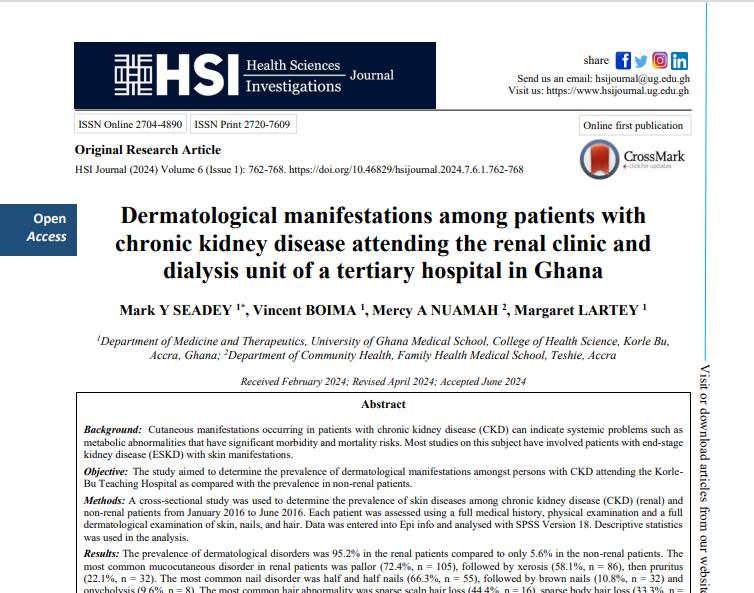Dermatological manifestations among patients with chronic kidney disease attending the renal clinic and dialysis unit of a tertiary hospital in Ghana
Dermatological manifestations amongst patients with chronic kidney disease
Abstract
Background: Cutaneous manifestations occurring in patients with chronic kidney disease (CKD) can indicate systemic problems such as metabolic abnormalities that have significant morbidity and mortality risks. Most studies on this subject have involved patients with end-stage kidney disease (ESKD) with skin manifestations.
Objective: The study aimed to determine the prevalence of dermatological manifestations amongst persons with CKD attending the KorleBu Teaching Hospital as compared with the prevalence in non-renal patients.
Methods: A cross-sectional study was used to determine the prevalence of skin diseases among chronic kidney disease (CKD) (renal) andnon-renal patients from January 2016 to June 2016. Each patient was assessed using a full medical history, physical examination and a full dermatological examination of skin, nails, and hair. Data was entered into Epi info and analysed with SPSS Version 18. Descriptive statistics was used in the analysis.
Results: The prevalence of dermatological disorders was 95.2% in the renal patients compared to only 5.6% in the non-renal patients. Themost common mucocutaneous disorder in renal patients was pallor (72.4%, n = 105), followed by xerosis (58.1%, n = 86), then pruritus (22.1%, n = 32). The most common nail disorder was half and half nails (66.3%, n = 55), followed by brown nails (10.8%, n = 32) and onycholysis (9.6%, n = 8). The most common hair abnormality was sparse scalp hair loss (44.4%, n = 16), sparse body hair loss (33.3%, n =12), and diffuse scalp hair loss (13.9%, n = 5).
Conclusion: The prevalence of skin disorders was higher in CKD patients than in patients without renal disease. Dermatological manifestations are an important component of CKD symptomatology, and healthcare providers should aim to recognise, diagnose, and managethem to improve patient outcomes.


